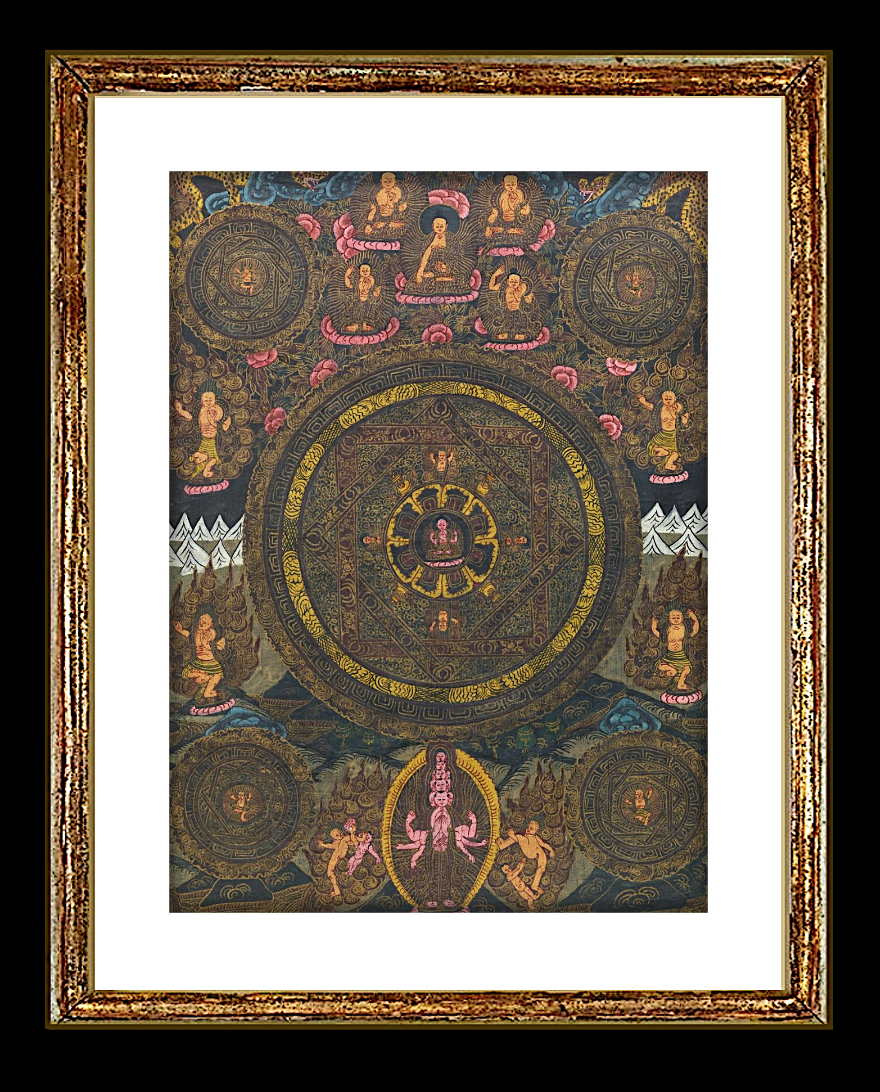

Title: 19th Century Antique Tibetan Tribal Hand-Painting Thangka
Shipping: $29.00
Artist: N/A
Period: 19th Century
History: Ancient Art
Origin: Central Asia > Nepal
Condition: N/A
Item Date: N/A
Item ID: 459
A 20th-century Tibetan Hand-Painted Thangka on Silk-Linen Blend. Consisting of hand-painted polychrome Colors. Mandala of Multiple manifestation of Buddha with Dragons, girl highlights on dark background. 18 ⅜" x 14 ¼" Provenance: old private collection, acquired in Kathmandu, Nepal, in mid 1970's-1980's. The Mandala of Multiple Manifestations of Buddha with Dragons is a complex and intricate image that is rich in symbolism and meaning. Here are three elements of this mandala: Dragons - In Tibetan Buddhism, dragons are powerful symbols of transformation and enlightenment. They are often associated with the element of water and are believed to have the power to purify and transform negative energy. In the Mandala of Multiple Manifestations of Buddha with Dragons, the dragons are depicted in various poses and colors, representing different aspects of their power and significance. Buddhas - The mandala features numerous representations of Buddhas, each with their own unique characteristics and symbolism. These Buddhas are believed to represent different aspects of the enlightened mind, and are associated with various qualities such as compassion, wisdom, and fearlessness. In the Mandala of Multiple Manifestations of Buddha with Dragons, the Buddhas are depicted in different colors, poses, and mudras (hand gestures), each representing a different aspect of their enlightened nature. Mandalas - The Mandala of Multiple Manifestations of Buddha with Dragons is itself a mandala, which is a symbolic representation of the universe and the enlightened mind. The mandala is a sacred space that is used for meditation and contemplation and is believed to help practitioners connect with the divine. In the Mandala of Multiple Manifestations of Buddha with Dragons, the mandala is depicted as a complex geometric pattern, with numerous smaller mandalas and symbols contained within it. The intricate details of the mandala are believed to represent the complex interplay of the different aspects of the enlightened mind and the universe.
Tibetan Buddhist paintings, also known as thangkas, have a long and rich history that dates back over a thousand years. These paintings are typically created on cotton or silk fabric, and are often adorned with brocade or silk borders. Thangkas serve as visual aids for meditation and as objects of devotion in Tibetan Buddhism. The origins of thangka painting can be traced back to the 7th century CE, when Buddhism was first introduced to Tibet from India. The earliest thangkas were likely created by Indian artists, who taught their techniques to local Tibetans. These early thangkas depicted Buddhist deities and teachings, and were used to help spread Buddhism throughout Tibet. Over time, thangka painting developed into a distinct art form in its own right, with its own unique styles and techniques. Thangkas became more complex and intricate, with detailed depictions of deities, mandalas, and other symbolic images. One of the most important developments in the history of thangka painting was the establishment of the Karma Gardri tradition in the 15th century. This tradition, which is still practiced today, is known for its highly precise and detailed depictions of deities and other figures. Thangkas also played an important role in the development of Tibetan Buddhist monasticism. Monks would often spend many years studying and meditating on thangkas, using them as tools for spiritual development and enlightenment. In addition to their religious significance, thangkas are also highly valued as works of art. Many thangkas have been created by famous artists throughout history, and are considered to be masterpieces of Tibetan Buddhist art. Today, thangka painting remains an important aspect of Tibetan culture and religion. Thangkas are still created by artists using traditional techniques, and are widely used in meditation and worship. They are also highly valued by collectors and art enthusiasts around the world.